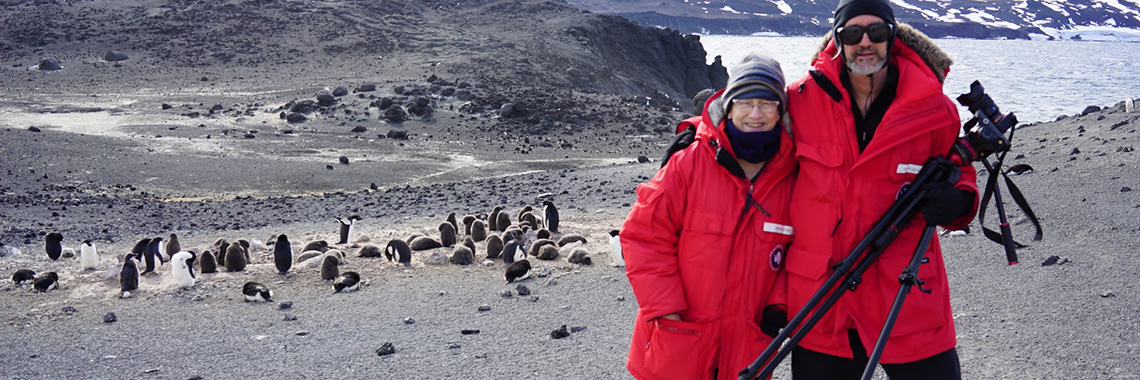Picture, or It Didn't Happen
LSU Researchers Recreate Famous Antarctic Photographs, With a Twist.
By: Paige Jarreau
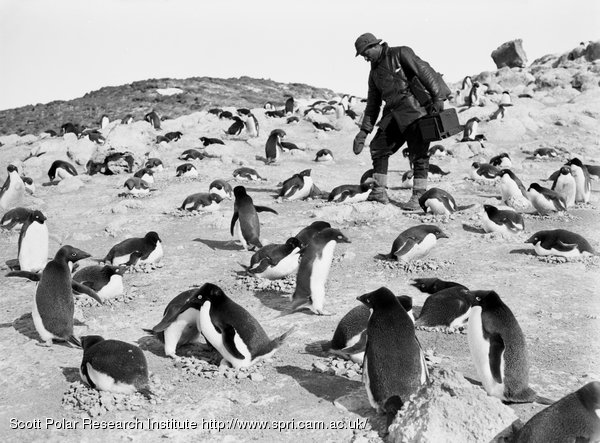
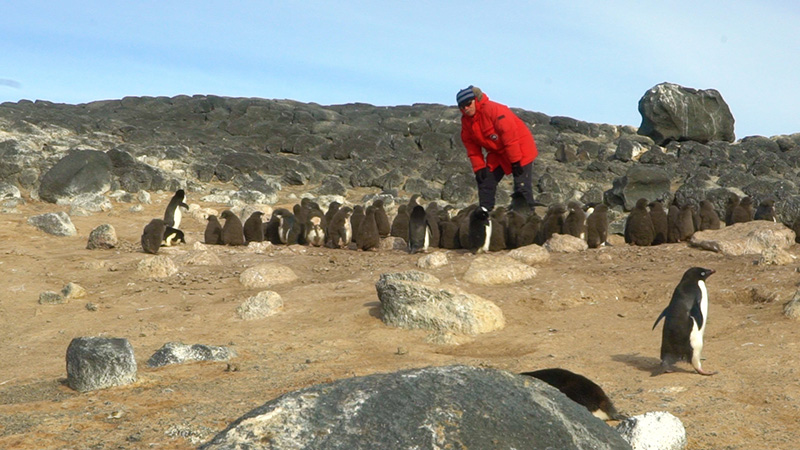
At top, the historic image of Ponting (Scott Polar Research Institute) with a modern image of David Ainley, a leading expert on Adélie penguins, below.
Photo: Trish Suchy and Vince LiCata
With the help of a National Science Foundation (NSF) Antarctic Artist and Writers Program grant, LSU faculty Trish Suchy and Vince LiCata embarked on a wild journey to document Antarctica's modern explorers, but with an eye to the past.
By the turn of the 20th century, a desperate race to the South Pole lured explorers and researchers into one of the harshest environments on our planet. In 1909, Ernest Henry Shackleton turned around just over 110 miles from the pole, his party weak and ill. In 1911, Norwegian explorer Roald Amundsen and British explorer Robert Falcon Scott both embarked on a journey to plant their flags at the bottom of the earth.
Amundsen’s party arrived first, proudly leaving the flag of Norway to wave in the icy winds at the South Pole on December 14, 1911. In early January, Captain Scott’s party trudged through the snow only to find they were 34 days too late. But people don’t remember Amundsen’s expedition. They remember Captain Scott’s.
Among those in Scott’s party who reached the pole, all perished on the return journey, including Scott. But their expedition succeeded where Amundsen’s failed. They took pictures. Professional photographer Herbert George Ponting documented the British Antarctic Expedition in hundreds of high-quality, now historic photographs, today found all over the web.
“Scott’s party became significantly more famous than Amundsen’s party,” said Vince LiCata, Louis S. Flowers Professor in the Department of Biological Sciences within LSU’s College of Science. “This was partly because of their martyrdom, but partly because they accomplished such great photographic work during their journey.”
“Both Shackleton and Scott took professional photographers with them on their expeditions. In 1910, explorers like Scott were thinking about science communication in a way that many scientists still don’t today.”
- Vince LiCata
In the winter of 2016, LiCata and Trish Suchy, Jack and Mary Frances HopKins Professor and associate professor in LSU’s Department of Communication Studies, spent two months in Antarctica developing content for an innovative multimedia exhibit titled Antarctica: Persistence of Vision.
“There are some people who are bizarrely obsessed with Antarctic exploration. Trish, my co-author, is one of those people,” LiCata laughed. “I’ve been reading about the history of these expeditions for the past 20 years,” Suchy said. She even has a dog named Shackleton. But visiting Antarctica to explore this history first-hand was only a pipe dream until Suchy discovered NSF had a program for science art projects in Antarctica. When she approached LiCata with the idea of developing a multimedia project about Antarctica, he was infected by her enthusiasm.
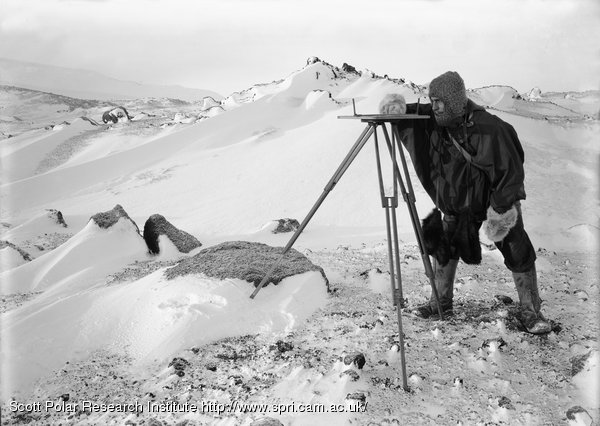
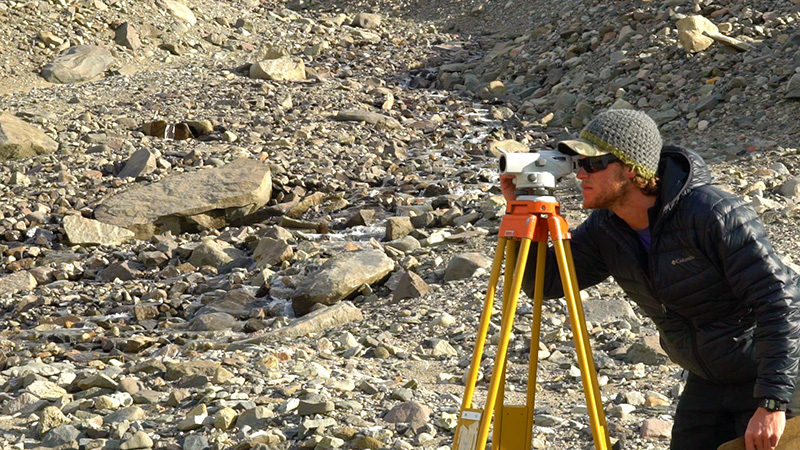
At top, a historic image of geologist Frank Debenham with a modern image of hydrologist Zach Sudman surveying a stream in the McMurdo Dry Valleys below.
Photo: Trish Suchy and Vince LiCata
“Working with Vince in the past, I became interested in this idea that scientists often use technology as a prosthesis to see things that the human eye can’t see,” Suchy said. “This is also one of the functions of documentary film.”
Suchy become fascinated with the parallel uses of imaging technology in both science and art. Suchy and LiCata got to work pitching project ideas to the NSF’s Antarctic Artists & Writers Program. But the program rejected their first proposal.
“They said it was too diffuse and unfocused,” LiCata said. “So we brainstormed and focused it down to re-creating these historic images.”
The second proposal was a hit, and they prepared to visit one of the most extreme environments on Earth. But it was several years after their proposal was approved that LiCata and Suchy finally landed in Antarctica in a cargo plane on skis.
“It was surreal. It was harder than I thought it would be,” Suchy said. The project relied on coordination and cooperation with dozens of scientists and contract workers in Antarctica. “Our subjects weren’t penguins. They were the researchers.”
Suchy and LiCata’s project ties together images from Captain Scott’s expedition at the turn of the 20th century with modern video portraits. Several of the portraits were installed this summer at the Lautaret Gardens Alpine Research Station, owned by the University of Grenoble Alpes, in Col du Lautaret, France. The research station has historical connections to Scott’s expedition. It tested the early snowmobiles that Scott and other explorers used on their expeditions to Antarctica.
Video portraits are a modern artform that demand patience and reflection in an age of instantaneously rewarding media. In Robert Wilson’s famous video portrait of Winona Ryder, the actress stares at the camera for seven minutes, wearing a hat adorned by flowers and buried up to her neck in sand. The scene lighting flows from dawn to dusk. As the light wanes, Ryder turns her head slowly to the side and looks down, and the video ends.
“It’s a picture, but it’s video,” LiCata said. “That’s what we were doing with the scientists and researchers. But we were posing them to re-stage photographs from Robert Scott’s expedition to Antarctica.”
The Antarctica: Persistence of Vision videos feature both the historic photos and recreated video footage. “The old photo slowly cross-fades to the new video, and cross-fades back,” LiCata said. “There’s a long period where you can see both the old photo and the new video at the same time, so that the historic figures and the modern researchers overlap. Sometimes they overlap frighteningly well.”
For most of the portraits a close tie exists between the action in the historic photo and the scientific work depicted in the modern video. One of the portraits now installed in Col du Lautaret features a famous photograph of Herbert Ponting at Cape Royds, surrounded by penguins as he hunches over reaching toward an individual penguin. In the exhibition video, this historic photograph cross-fades into a video portrait of David Ainley, the world’s leading expert on Adélie penguins.
“He is standing in exactly the same spot, surrounded by penguins, reaching over to touch a penguin,” LiCata said. “When you look at it, you can even identify rocks that are the same in the historic photo and the video portrait.” The historic photo and the modern video are roughly 100 years apart, making it a surreal experience to see them overlapping at a single moment in time.
Suchy and LiCata had scientists clamoring to be featured in the modern video remakes of the historic photographs of Captain Scott’s expedition. Nearly every researcher they asked enthusiastically agreed to take part. Suchy said many of the participants expressed that performing the actions depicted in the historic photographs made them feel closer to the explorers who had paved the way for the science happening in Antarctica today.
“We had people coming up to us while we were shooting in Antarctica, asking if there was any way they could be in one of the portraits,” LiCata said. “It was really awesome.”
Suchy and LiCata had many goals for their video portrait project, but one goal in particular stands out. They were striving to show the connection between research today and in the past.
“A lot of the same research depicted in these historical photographs is continuing today, because scientific problems aren’t solved in the span of a couple of years or even a century sometimes,” LiCata said. Earlier this year, Suchy published an essay about a performance she staged recounting a 1911-1913 expedition known as “the worst journey in the world,” in which researchers journeyed in temperatures below -80 degrees Fahrenheit to obtain Emperor penguin eggs in Antarctica. By studying these eggs, the researchers hoped to find the missing link between dinosaurs and modern birds. But the expedition resulted in many human fatalities and penguin eggs that were of limited scientific value.
“You have to go through a lot of things that aren’t right, before you hit what is right.”
- Trish Suchy
“Research inherently involves finding penguin eggs that are dead ends, looking for one thing but finding something else, or describing something that isn’t immediately useful but later on helps someone else solve a different problem,” Suchy said. With their video portraits, Suchy and LiCata wanted to show that research is connected through time and that cooperation and a sense of openness in science is vital to progress.
“People often have bizarre ideas of what scientists are, and what scientists do,” LiCata said. “We wanted to show pictures of scientists working in Antarctica, in normal clothes, in their winter coats, doing what they do.”
The video portraits show viewers that raw exploration is still happening in the world today. “There are many places in Antarctica that aren’t fully mapped out yet,” LiCata said. “We were surprised when we got there, that there’s a glacial stream named after LSU faculty member Peter Doran. It’s because the glacier has been mapped so recently, that they could name it after an active researcher in the geology department at LSU. Right now, the mapping is still going on in Antarctica.
------
Explore Antarctica yourself, at LSU: Suchy and LiCata’s full exhibition will premiere in the Hopkins Black Box Theatre in March 2017. See the Hopkins Black Box Theatre schedule for 2016-17 for more information.
LiCata writes about his journey to Antarctica on his science blog, World’s Fair. Suchy documents behind-the-scenes moments on her blog, Beyond The Utmost Bound.
